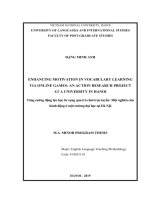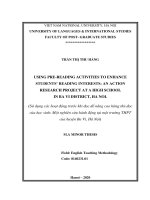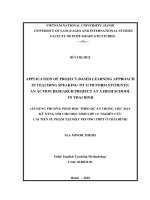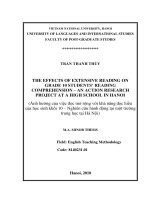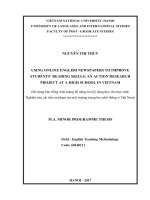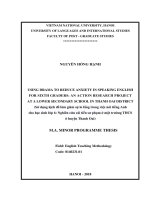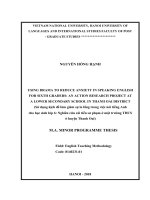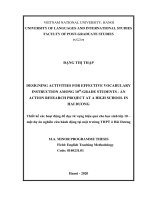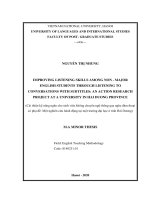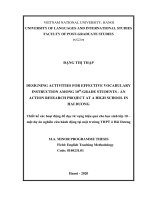Enhancing motivation in vocabulary learning via online games an action research project at a university in hanoi
Bạn đang xem bản rút gọn của tài liệu. Xem và tải ngay bản đầy đủ của tài liệu tại đây (1.23 MB, 67 trang )
VIETNAM NATIONAL UNIVERSITY, HANOI
UNIVERSITY OF LANGUAGES AND INTERNATIONAL STUDIES
FACULTY OF POST-GRADUATE STUDIES
ĐẶNG MINH ANH
ENHANCING MOTIVATION IN VOCABULARY LEARNING
VIA ONLINE GAMES: AN ACTION RESEARCH PROJECT
AT A UNIVERSITY IN HANOI
Tăng cường động lực học từ vựng qua trò chơi trực tuyến: Một nghiên cứu
hành động ở một trường đại học tại Hà Nội
M.A. MINOR PROGRAM THESIS
Major: English Language Teaching Methodology
Code: 8140231.01
HANOI - 2019
VIETNAM NATIONAL UNIVERSITY, HANOI
UNIVERSITY OF LANGUAGES AND INTERNATIONAL STUDIES
FACULTY OF POST-GRADUATE STUDIES
ĐẶNG MINH ANH
ENHANCING MOTIVATION IN VOCABULARY LEARNING
VIA ONLINE GAMES: AN ACTION RESEARCH PROJECT
AT A UNIVERSITY IN HANOI
Tăng cường động lực học từ vựng qua trò chơi trực tuyến: Một nghiên cứu
hành động ở một trường đại học tại Hà Nội
M.A. MINOR PROGRAM THESIS
Major: English Language Teaching Methodology
Code: 8140231.01
Supervisor: Hoàng Thị Xuân Hoa, PhD.
HANOI - 2019
DECLARATION
I certify that the work presented in this research report has been performed
and interpreted solely by myself. I confirm that this paper is submitted in fulfillment
of the requirement for the M.A. Degree and has not been submitted elsewhere in
any other form for the fulfillment of any other degree or qualification.
Hanoi, 2019
Đặng Minh Anh
i
ACKNOWLEDGEMENTS
This M.A thesis could not have been accomplished without the invaluable
help, encouragement and support form a number of people who I would like to
show my sincerest gratitude and appreciation.
To begin with, I would like to express my greatest and deepest thankfulness
to my supervisor, Hoàng Thị Xuân Hoa, PhD., for her enthusiastic and precious
guideline and advice throughout the duration of my thesis. Without her instruction
and supervision, this thesis could not have reached the fulfillment.
Moreover, my honest thanks also come to all students for taking part in
this study.
Last but not least, I give my thanks to family and relatives who have always
supported me and supplied the best conditions for me to complete this thesis.
ii
ABSTRACT
The present thesis was conducted to examine the extent to which the application of
Online games could help to enhance the students‟ motivation in learning
vocabulary. Participants of this study were 28 low-level students in a non-English
major university in Hanoi. Online games was used as the strategy to enhance
students‟ motivation in vocabulary learning. This thesis was designed as an action
research. The whole process of the research was divided into four steps of planning,
implementing, observing
and reflecting on progress with aims to reduce the
problems and to improve students‟ motivation in learning vocabulary. The research
questions to be addressed in the thesis are: (1) To what extent do online games have
influences on students‟ motivation in learning vocabulary? (2) What are students‟
opinions towards the application of these games in vocabulary learning. Survey
questionnaire, semi-structured interview and classroom observation were used as
instruments to collect data for reflection throughout the research. The results had
confirmed the positive effects of online games on enhancing their motivation in
vocabulary learning as the level of motivation after the intervention was increase
significantly in comparison with that before the intervention. In addition, the results
indicated that the students had positive opinions towards application of online
games in vocabulary learning in all aspects of ARSC model.
Keywords: action research, vocabulary, motivation, online games, ARSC model
iii
TABLE OF CONTENTS
DECLARATION ....................................................................................................... i
ACKNOWLEDGEMENTS ..................................................................................... ii
ABSTRACT ............................................................................................................. iii
LIST OF TABLES ................................................................................................. vii
LIST OF FIGURES ............................................................................................... vii
LIST OF ABBREVIATIONS............................................................................... viii
PART A: INTRODUCTION ....................................................................................1
1. Rationale .................................................................................................................1
2. Research aims ..........................................................................................................3
3. Research questions ..................................................................................................3
4. Scope of the study ...................................................................................................4
5. Method of the study ................................................................................................4
6. Significance of the study .........................................................................................4
7. Design of the thesis .................................................................................................5
PART B: DEVELOPMENT.....................................................................................6
CHAPTER 1: LITERATURE REVIEW ................................................................6
1.1. Vocabulary in language learning and teaching ....................................................6
1.1.1. The importance of vocabulary learning ............................................................6
1.1.2. Process of vocabulary teaching .........................................................................7
1.2. Motivation in learning vocabulary .......................................................................8
1.2.1. Nature of Motivation .........................................................................................8
1.2.2. Kinds of Motivation ..........................................................................................9
1.2.2. Methods to enhance motivation in learning ....................................................11
1.2.3. ARSC Motivational Design model .................................................................12
1.3. The application of online vocabulary games in EFL classroom ........................14
1.3.1. Definition and classification of games in language learning ..........................14
1.3.2. The application of games in teaching vocabulary ...........................................15
iv
1.3.3. The benefits of online vocabulary games .......................................................16
CHAPTER 2: METHODOLOGY .........................................................................18
2.1. Action research ...................................................................................................18
2.2 Research design ...................................................................................................19
2.3. Participant selection ...........................................................................................20
2.4. Materials .............................................................................................................20
2.5. Intervention ........................................................................................................20
2.6. Instruments .........................................................................................................22
2.6.1. Survey questionnaire .......................................................................................22
2.6.2. Semi-interview ................................................................................................23
2.6.3. Observation .....................................................................................................24
2.7. The study procedure ...........................................................................................24
2.7.1. Identify the problems ......................................................................................24
2.7.2. Action plan ......................................................................................................25
2.7.3. Evaluating the plan ..........................................................................................27
2.8. Data collection procedure ..................................................................................27
2.9. Data analysis method and procedure .................................................................27
2.9.1. Survey questionnaire .......................................................................................28
2.9.2. Semi-structured interview ...............................................................................30
2.6.3. Observation .....................................................................................................30
CHAPTER 3: FINDINGS ......................................................................................31
3.1. Survey questionnaire ..........................................................................................31
3.1.1. Questionnaire on Motivation in learning vocabulary .....................................31
3..1.2. Questionnaire on the Use of online games.....................................................33
3.2. Semi-structured interview ..................................................................................36
3.3. Observation ........................................................................................................37
CHAPTER 4: DISCUSSIONS ...............................................................................40
PART C: CONCLUSIONS ....................................................................................42
1. Summary of findings .............................................................................................42
v
2. Implications ...........................................................................................................42
3. Limitations ............................................................................................................43
4. Recommendations .................................................................................................43
5. Reflections.............................................................................................................43
REFERENCES ........................................................................................................45
APPENDICES .........................................................................................................51
APPENDIX A: Pre-intervention questionnaire ...................................................51
APPENDIX B: Post-intervention questionnaire ..................................................52
APPENDIX C: Survey questionnaire ...................................................................53
APPENDIX D: Open-ended interview questions .................................................56
APPENDIX E: Teacher observation record .........................................................57
vi
LIST OF TABLES
Table 2.1. IMMS scoring guide ................................................................................29
Table 3.1. Descriptive statistics of students‟ motivation in learning vocabulary .....31
Table 3.2. Comparison of motivation between pre- and post-intervention. .............32
Table 3.3. Scale reliability based on Cronbach‟s alpha ............................................33
Table 3.4. Range of motivation level ........................................................................34
Table 3.5. Overall mean scores of students‟ evaluation ...........................................34
Table 3.6. Numbers of respondents in each level .....................................................34
LIST OF FIGURES
Figure 2.1. Action research model ............................................................................19
Figure 3.1. Descriptive statistics of Pre-test and Post-test on motivation in learning
vocabulary .................................................................................................................32
Figure 3.2. Percentages of respondents in each level ...............................................35
Figure 3.3. Descriptive statistics of Game evaluation in each scale .........................36
vii
LIST OF ABBREVIATIONS
ARSC
Attention, relevance, satisfaction, confident
CIS
Course Interest Survey
CLT
Communicative language teaching
EFL
English as a Foreign Language
ESL
English as a Second Language
IMMS
Instructional Materials Motivation Survey
viii
PART A: INTRODUCTION
This part gave overviews on rationale of the study, research aims, research
questions, scope methods and design of the study.
1. Rationale
Vocabulary is the core of any language and one cannot learn language without
vocabulary. Emphasizing on the important of vocabulary in language learning,
Wilkins (1972) believed that without grammar very little can be conveyed,
however, without vocabulary nothing can be conveyed. The importance of
vocabulary in foreign language learning cannot be emphasized enough that without
it there is little success for effective communication (Vermeer, 1992) as it is upon
words that the structure of language is built and it is words that constitute the raw
material for the creation of sentences (Ross & Jan, 2007).
However, in spite of its significant role, vocabulary learning seemed to be one
of the most common problems in language learning for ELF students. In this current
thesis, the researcher found that despite realizing the importance of vocabulary in
language learning, students appeared to have low level of motivation in learning
vocabulary. According to results of observations and interviews in with students,
some problems were identified. Most of students found vocabulary learning tiring
and boring process or they feel it is too difficult for them to learn and understand.
Moreover, the practices and exercises which they are asked to complete were not
related to students‟ interests. Those can be caused by inappropriate teacher styles
and methods using by teacher. It worth to note the fact that in most traditional class,
vocabulary was taught with the teaching method of grammar-translation. Since
students should not see the vocabulary learning process as a boring process, but as a
useful and interesting one, it is essential for teachers to find out and apply a new
strategy in order to motivate students in learning vocabulary.
Among a variety of methods and techniques, games was proposed as an useful
1
strategy which increases students‟ motivation especially in learning vocabulary.
Many researchers support the use of vocabulary games due to their educational
values. According to these researches, a game-based learning context helps to shape
a higher level of motivation of an individual (Ebrahimzadeh & Alavi, 2017).
Application of games in classroom context provides the students with an exciting
learning experience (Icard, 2014). Therefore, students become attentive because
games make their learning more enjoyable. By using games students can be more
active, autonomous, and energetic, learn about environment, the world they are
living in, and be engaged in the teaching-learning process. We can teach all skills
and components through playing games, which is based on a learner-centered
approach, meanwhile when we are teaching; we have to pay attention to the
meaningfulness, appropriateness and the level of the learners (Widodo, 2006).
In addition, with the development and evolution of Internet technology, there
was an increasing trend towards online learning environment in which, online
games were applied instead of traditional vocabulary games. (Wichadee &
Pattanapichet, 2018). Online vocabulary games are supposed to inherit the benefits
of traditional ones but to be employed with more interesting design. The researcher
believed that using online games in the classrooms is considered a good source of
entertainment in the classroom that helps students learn and interact with given
material in order to learn and acquire a new language. Online games could change
the way students are accustomed to learning while they sit passively in a classroom
and expect the teacher to give them the needed information in order to learn the
English language. By accessing to Internet, students can easily participate actively
in online interactive games via devices such as their mobile phones or laptops.
Realizing the low level of students' motivation in learning vocabulary, the
researcher believed that an immediate change was necessitated. With the aim of
creating an relaxed, motivating, and enjoyable environment where students are
interested and encouraged to learn vocabulary, this thesis was conducted as an
action research with the application of Online games in English lesson as a strategy
2
to tackle the problems. The current study aimed to investigate the extent to which
online games help enhancing students‟ motivation in learning vocabulary as well as
examine their opinions towards the implementation of games. It is hoped that the
results will provide insights into the application of online games as motivator in
vocabulary learning in particular and in language learning in general.
2. Research aims
Vocabulary is the basis of any language to be learned and how to motivate the
learners to learn vocabulary is of a great significance in the field of English
language teaching. To solve the problems in teaching and learning process, this
current thesis was carried out with the aims of an action research of: (1) identify the
level of students‟ motivation in vocabulary learning through the use of data
collection techniques, (2) design, implement and evaluate an action plan in order to
solve the problem. Specifically, after identified the problems of students‟ low
motivation in learning vocabulary, the researcher tries to solve it through the
application of a new strategy which can affect the students‟ motivation as well as
engage them in learning vocabulary. In this current research, online games were
designed and implemented in English lesson for the duration of fifteen weeks. After
that, the application of these games would be evaluated. The extent to which online
games have influences on students‟ motivation in learning vocabulary were
examined. In addition, the students‟ opinions toward the implementation of these
games in English lesson were analyzed.
3. Research questions
The above overall aims are expected to be fulfilled by addressing the
following research questions:
(1) To what extent do online games have influences on students‟ motivation in
learning vocabulary?
(2) What are students‟ opinions on the application of online games in English
lesson?
3
The researcher hold a strong believe that the application of online games
would significantly improve students‟ motivation in learning vocabulary. Moreover,
students would had positive opinions towards the use of those games. To examine
my hypothesis, I have compared the results of questionnaires on motivation level of
the students before and after the application using SPSS software. In order to figure
out students‟ opinions on those games, questionnaires on the use of online games
were collected and analyzed in overall and in each aspect of ARCS motivation
model.
4. Scope of the study
In this study, the researcher does not have the ambition to study all the
influences of online games on the students‟ development of language and skills in
general. Due to the significance of vocabulary development and the low level of
motivation of students mentioned above, this study only focuses on the influences
of online games on the students‟ motivation in vocabulary learning. In addition, the
online games that is chosen for the action research is Kahoot. In addition, based on
the features of application, Keller‟s 2010 ASRCS motivation model was employed
in this thesis.
5. Method of the study
This is an action research with the participants of 28 low-level students at a
non- English major university in Hanoi. The purpose of this thesis was to conduct
an action research to tackle the problem of their low motivation in learning
vocabulary through the use of online games for duration of 15 weeks. The whole
process of the research was divided into four steps of planning, implementing,
observing and reflecting on progress. Classroom observation, survey questionnaires
and semi-structured interviews were used as instruments to collect data for
reflection throughout the research.
6. Significance of the study
Firstly, as an action research, the plan of this study can be used as an
immediate solution to my current students' problem in learning their essential
4
vocabularies. For the students, as mentioned in the statement of the problem, they
have troubles in learning vocabulary due to the traditional teaching strategy and
tiring practice exercises. Therefore, this action research is expected to bring up a
new strategy which can highly motivate and engage students in the vocabulary
learning.
On the other hand, with the findings of this study, this research is expected to
provide benefits for writer, readers, teachers and school. For the writer, the research
result can bring along knowledge and experience to do research in theoretical and
practical manner. For readers, it can improve their knowledge to get information or
reference especially motivation in vocabulary learning with the use of online games.
The practical benefit of this research for the teachers that it can use as inputs in
applied for English teacher in teaching and learning to improve vocabulary learning
motivation through online games. For the schools, it can give useful information to
improve the quality of vocabulary teaching and learning process in school.
7. Design of the thesis
This thesis consists of three parts:
Part A: Introduction presents the rationale for conducting the study a longing
with its aims, research questions, methods, significance and design.
Part B: Development including four chapters:
Chapter 1 - Literature Review conceptualizes the framework of the study
including the key concepts. A brief overview of the related studies are also
provided.
Chapter 2 - Research methodology presents the context, the methodology used
in this study including the objects, data collection instruments, data collection
procedure and analysis.
Chapter 3 – Findings presents and gives a comprehensive analysis of the data.
Chapter 4 – Discussion gives on the findings of this study.
Part C: Conclusion offers the summary of findings, implications, limitations,
recommendations and reflection of the researcher.
5
PART B: DEVELOPMENT
CHAPTER 1: LITERATURE REVIEW
This chapter conceptualizes the framework of the study including key
concepts of vocabulary, motivation and the application of online vocabulary games
in EFL classroom.
1.1. Vocabulary in language learning and teaching
Vocabulary is one element that links the four skills of speaking, listening,
reading and writing all together, consequently, its definition relates to various views
about its nature and its use.
Researchers and experts seemed to have different viewpoint vocabulary in
language learning. Vocabulary is defined as the total number of words in a language
Hornby (1995). It is considered as all the words that received by human incidentally
or intentionally through indirect exposure to words explicitly instruction to specific
word and word- learning strategy (Setiyaningsih, 2009).
1.1.1. The importance of vocabulary learning
Vocabulary functions as a core without which any language could not exist.
Studying a language cannot be separated from studying vocabulary because when
we are learning speaking, reading listening and writing we all need vocabulary
which constitutes the knowledge of meaning is one of the components of a
language. For instance, language communication would be meaningless and perhaps
impossible to have only structure without vocabulary. Learning a foreign language
requires a strong knowledge of its vocabulary rather than its grammar as a person
can say very little with grammar, but can say almost anything with vocabulary.
(Wilkins, 1972).
In traditional methods, vocabulary was not considered as a major subject to be
separately and officially taught. Instead of being a particular subject of students to
learn, it was included at the margin within lessons of speaking, listening, reading
and writing. Recently, with the emergence of methods such as CBA and CLT,
6
vocabulary teaching and learning process has been developed and gets such an
importance in EFL classes especially. (Darfilal, 2015),
Considering the importance of vocabulary, it is believed that the school must
emphasize understanding by teaching the proper use of words at all times.
Promoting the growth of writing, speaking, reading, and listening vocabularies is a
most important function of the language program in every classroom.
Generally, learning vocabulary is an important and inspirable part of learning
a language. Whenever we want to communicate with other people using a language,
we should have mastered vocabulary related to the topic, therefore, it acts as one of
the components supporting communication. In other words, the important role of
vocabulary in developing the four language skill is undeniable.
1.1.2. Process of vocabulary teaching
Vocabulary teaching is a continuous process, where learners meet the words
many times in their learning to increase and deepen their knowledge and their use of
words in the foreign language. It is also facilitated through using meaningful
activities to practice vocabulary, as it provides the learners with opportunities to
memorize the words effectively, more than if they just practice them orally by
drilling or by using flashcards. (Cameron, 2001).
Activities which involve learners in thinking about the words and making
decisions about them allow learners to remember the words effectively. To ensure
long term recall and retention, new knowledge should be integrated to old/existing
knowledge, i.e. they need to be placed into working memory e.g. being compared,
combined, matched, sorted, visualized and re- shuffled, as well as being repeatedly
filed away and recalled. It means that students need exposure to a variety of
activities that challenge their thinking and promote their decision making.
(Thornbury, 2002).
Vocabulary could not be learnt in isolation. As Nunan (1995) suggested, when
teaching new vocabulary, we should begin by teaching the new item in context,
however, at a later stage learners should be given the opportunity of dealing with
7
the words out of context. Kang (1995) found that one of the best ways to enhance
second language vocabulary learning is to use a context-embedded approach in
which new words are presented in context. In his study, target English words, with
their meanings and one or more example sentences, were presented to learners via
computer audio. Learners could hear the target words as many times as desired.
All in all, vocabulary has an important role in the developing of teaching and
learning, so the teacher should be taught vocabulary to the student since the students
young so that the learner will easy to master vocabulary and they can reach the
goals of teaching and learning a foreign language, that is produce a language in
speaking, reading, and writing.
1.2. Motivation in learning vocabulary
1.2.1. Nature of Motivation
Despite the importance role of motivation in learning additional languages,
there is, in fact, no agreement on the exact definition of motivation. Despite
motivation is a term frequently used in both educational and research contexts, it is
rather surprising how little agreement there is in the literature with regard to the
exact meaning of the concept (Dörnyei, 2001).
Motivation is considered the “internal drive” that pushes somebody to do
something. If we think that our goal is worth doing and attractive for us , then we
try to reach that goal. This is called the action driven by motivation (Harmer, 1991).
On the other hand, motivation was define as an important component or factor in
the learning process. Learning and motivation have the same importance in order to
achieve something. Learning makes us gain new knowledge and skills and
motivation pushes us or encourage us to go through the learning process. (Parsons,
Hinson & Brown, 2001). In his socio-educational model, motivation is perceived to
be composed of three elements. These are effort, desire and affect. Effort refers to
the time spent studying the language and the drive of the learner. Desire indicates
how much the learner wants to become proficient in the language, and affect means
the learner‟s emotional reactions related to language study (Gardner, 1982).
8
1.2.2. Kinds of Motivation
Motivation can be classified into different categorized as mentioned below.
Harmer (1991) categorized motivation into two types of Short-term goal and
Long-term goal.
Short-term goal: when students wish to succeed in doing something in the
near future, for example, students who want to pass their examination or to get good
grade or high scores
Long-term goal: a wish of students or learners who want to get a better job in
the future or to be able to communicate with people who use the language that they
study or the target language.
Krashen (1988) divided motivation in term of relation between the second
language ability consisting of two functions of Integrative motivation and
Instrumental motivation.
Integrative motivation: Integrative motivation is defined as the desire to be a
part of recognized or important members of the community or that society that
speak the second language. It is based on interest in learning the second language
because of their need to learn about, associate or socialize with the people who use
it or because of purpose or intention to participate or integrate in the second
language using the same language in that community.
Instrumental motivation: Instrumental motivation involves the concepts of
purely practical value in learning the second language in order to increase learners‟
careers or business opportunities, giving them more prestige and power, accessing
scientific and technical information, or just passing a course of their study in school.
In other studies, the motivation is further classified into two main categories as
Extrinsic motivation and Intrinsic motivation.
Extrinsic motivation: Extrinsic motivation refers to a desire to get a reward
and avoid punishment. It emphasizes external need to persuade the learner to take
part in learning activity (Arnold, 2000), such as homework, grade, or doing
something to please teachers. Both integrative and instrumental motivations are also
9
grouped under the branch of the extrinsic motivation (Harmer, 1991). As extrinsic
motivation is based on external outcomes such as rewards and punishment. This
motivation could bring a negative impact to the students, because with extrinsic
motivation, students do not learn with their strong intention or will but they study it
because they are pushed by the interest in the rewards or the punishment. When a
student is learning because he is promised rewards or because he wants the rewards
, he will be highly motivated to come to classes and learn and achieve the goal that
is set for him. But when these rewards are taken away, or sometimes even if they do
not see any punishment, the student will not be interested in coming to class and
learn the language any longer.
Intrinsic motivation: Intrinsic motivation refers to learning itself having its
own reward (Arnold, 2000). It means the learners are willingly and voluntarily (not
compulsorily) try to learn what they think it is worth or important for them. When
students have intrinsic motivation, they have the internal desire to learn and they do
not have the need for external outcomes. There are no negative impacts in having
intrinsic motivation. In addition, intrinsic motivation pushes the student to learn
without rewards, because the need is innate or come from inside or depends on their
own will. Lightbown and Spada (1999) mentioned that teachers do not have many
effects on students‟ intrinsic motivation since the students are from different
backgrounds and the only way to motivate students is by making the classroom a
supportive environment.
According to Harmer (1991), factors that influence intrinsic motivation are:
Physical condition, Method, The teacher and Success.
Physical condition: It is clearly the case that physical condition have a great
effect in teaching and learning process and can alter students‟ motivation either
positively or negatively. Classroom that are badly lit and overcrowded can be
excessively de-motivating. So, the atmosphere in which a language is learnt is
vitally important.
10
Method: The method by which students are thought must have some effect on
their motivation. If they find it deadly boring they will probably become
demotivated, whereas if they have confidence in the method, they will find it
motivating.
The teacher: In this case, the teacher must show up her teaching as well as
possible, in order to students interested in her English teaching.
Success: Success or luck of it plays a vital in the motivational drive of
students. Both complete failure and success maybe de-motivating. It will be the
teachers job 24 to set goals and task at which most of her or his students can be
successful or rather task to be able to achieve.
1.2.2. Methods to enhance motivation in learning
In learning and teaching process, as the role of motivation, both of intrinsic
and extrinsic are needed. There are some forms and the ways to build the students‟
motivation in learning activities in language classroom were suggested by Shodiqin
(2015) as below:
Giving score: Score, in this case, as a symbol from the value of learning
activities. Many students study hard to get a good score. A good score for students
are strong motivation.
Competition: Competition can be used as an instrument to motivate the
students are studying hard. Competition both of individual or group, it can increase
students achievement in learning English.
Giving test: Students will study hard, if they know tomorrow there will be a
test. Giving a test includes of good motivation. But the teacher must remember, not
to be often giving a test (everyday) because, they will be bored. In this case the
teacher must be opened. It means if a teacher wants to give a test, they should give
an information to the students first.
Reward: Reward, can be divided into two, those are:
Giving a praise: When there is a student who succeeds and finishes his/her
work well, it necessary to give a praise. Giving praise is a form of positive
reinforcement.
11
Punishment: Punishment is a negative reinforcement; it can be as instrument
to motivate the students if the teacher gives it in good situation.
1.2.3. ARSC Motivational Design model
One of the motivation model that support the method mentions above was
ARCS Motivational Model. ARCS is an instructional model developed by John
Keller, and focuses on motivation. It is important to motivate the learners, and
ensure the continuity of the motivation during the instruction. There are four steps
for promoting and sustaining motivation in the learning process: Attention,
Relevance, Confidence, Satisfaction. (Keller, 2010)
The first category is Attention. This category is important for attracting a
student‟s attention such as changing the level of the tone or using a device to grab a
student‟s attention. The most important thing in this category is to arouse the
students‟ curiosity toward the learning material.
Methods for grabbing the learners‟ attention include the use of:
Active participation: Adopt strategies such as games, roleplay or other handson methods to get learners involved with the material or subject matter.
Variability: To better reinforce materials and account for individual
differences in learning styles, use a variety of methods in presenting material (e.g.
use of videos, short lectures, mini-discussion groups).
Humor: Maintain interest by use a small amount of humor (but not too much
to be distracting).
Incongruity and Conflict: A devil‟s advocate approach in which statements are
posed that go against a learner‟s past experiences.
Specific examples: Use a visual stimuli, story, or biography.
Inquiry: Pose questions or problems for the learners to solve, e.g.
brainstorming activities.
The second category is Relevance where the information is related to a
learner‟s experience. This will allow the learner to enjoy and achieve the learning
goal. For example, the instructor finds out what the learner likes and makes a
connection to the instruction.
12
Six major strategies described by Keller include:
Experience: Tell the learners how the new learning will use their existing
skills. We best learn by building upon our preset knowledge or skills.
Present Worth: What will the subject matter do for me today?
Future Usefulness: What will the subject matter do for me tomorrow?
Needs Matching: Take advantage of the dynamics of achievement, risk taking,
power, and affiliation.
Modeling: First of all, “be what you want them to do!” Other strategies
include guest speakers, videos, and having the learners who finish their work first to
serve as tutors.
Choice: Allow the learners to use different methods to pursue their work or
allowing s choice in how they organize it.
The third category is Confidence. In this category students will have a chance
to become independent and have the opportunity to practice new skills on their own
which will build their self-confidence toward the learning material.
Provide objectives and prerequisites: Help students understand their
likelihood for success. If they feel they cannot meet the objectives or that the cost
(time or effort) is too high, their motivation will decrease. Help students estimate
the probability of success by presenting performance requirements and evaluation
criteria. Ensure the learners are aware of performance requirements and evaluative
criteria.
Grow the Learners: Allow for success that is meaningful. Allow for small
steps of growth during the learning process.
Feedback: Provide feedback and support internal attributions for success.
Learner Control: Learners should feel some degree of control over their
learning and assessment. They should believe that their success is a direct result of
the amount of effort they have put forth.
The last category is Satisfaction. Students will feel good about what they
achieved from the instruction because if the students are satisfied, they will remain
motivated about what they have been taught.
13
Learning must be rewarding or satisfying in some way, whether it is from a
sense of achievement, praise from a higher-up, or mere entertainment. Make the
learner feel as though the skill is useful or beneficial by providing opportunities to
use newly acquired knowledge in a real setting. Provide feedback and
reinforcement. When learners appreciate the results, they will be motivated to learn.
Satisfaction is based upon motivation, which can be intrinsic or extrinsic. Do not
patronize the learner by over-rewarding easy tasks.
1.3. The application of online vocabulary games in EFL classroom
1.3.1. Definition and classification of games in language learning
There are many definition of games in the field of language teaching. Allery
(2004) defined a game as a competitive activity with a prescribed setting,
constrained by rules and procedures. The learning results from playing the game
and not from the academic content or specialist subject matter. According to Hunt
and Cain (1950) a game is: (1) A way of behaving in play which tends to conform
to a pattern that is generally formed and shared by several individuals; (2) The game
pattern is emphasized by the elements of organization which bring about a definite
and often repeated climax; (3) In a game, individuals do not lose their identity, for
the game itself is a situation in which the elements of success and failure are so
equally balanced that only players by their own efforts, practice, and application of
self can swing the balance to succeed.
According to Littlewood (1981) and Hadfield (1996), language games can be
categorized into (a) communicative games and pre- communicative games, (b)
Cooperation/ competitiveness game and techniques games. To start with,
communication games are those where the emphasis is on successful
communication. Communication games cover such communicative functions as
greeting, invitation, request, description, and narration, where the output is openended, unprescribed, or unpredictable. In contrast, pre- communicative are games
that stress accuracy of language use. As this type of games emphasize accuracy of
language use, they have explicit definitions, such as “structural games”. The aim of
14
structure-aimed games is to foster the linguistic ability for certain syntactic patterns,
some vocabulary areas and idiomatic expressions, spelling and pronunciation skills
and new vocabulary. In pre-communicative games, the participants‟ output is closeended to ensure the correctness of language use. In comparison between
cooperation/ competitiveness game and techniques games, the first issues to be
consider is classifying cooperation and competitiveness game. As it was named,
cooperation game contains the main action is organized into team- based activities
which encourage cooperation. The participants have to work together towards a
common goal. While, the latter type of games is excellent for encouraging shy
students, since they require the participation of all the members of a team, group or
pair. Some typical activities may include the completion of drawings, putting things
in order, grouping things, finding a pair or finding hidden things. Students are
involved in the exchange of information in order to complete a task and in the
giving or following of instructions. Different from those two above, techniques
include information-gap, problem-solving, guessing, search, matching, exchanging
and collecting, combining card games, puzzles and simulation.
1.3.2. The application of games in teaching vocabulary
Many researchers support the use of language games in the classroom. Some
studies have also been conduct investigating the characteristics of games that make
vocabulary learning more effectively. Nowak (1994) believed games is played
among students in the classroom to get better result in teaching and learning
process. Huang (1996) stated that learning through games could encourage the
operation of certain psychological and intellectual factors which could facilitate
communication heightened self-esteem, motivation and spontaneity, reinforcing
learning, improving intonation and building confidence. Uberman (1998) concluded
that games can be used as a way to help students not only enjoy and entertain with
the language they learn, but also practice it incidentally. Another advantage when
games are used in the classroom including a welcome break from the usual routine
of the language class, motivating and challenging, effort of learning, and language
15
